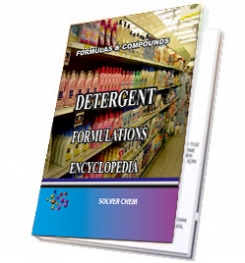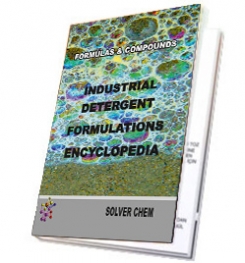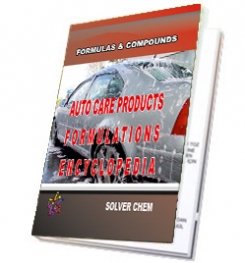Soaps are chemical compounds of fatty substances with alkalies; or of certain metallic oxides, as of lead, with fats. Those with lead form plasters, and those with lime are sometimes used as liniments; but these are not soluble in water, and are considered as soaps merely because of the analogy in the chemical changes which produce them. All the other soaps are soluble, are used as detergents, and have a moderate excess of alkalinity. They are of two general classes: 1st. Those made with the vegetable oils, as olive oil, almond oil, and palm oil. 2d. Those formed with the animal oils, as lard, tallow, suet, and resin. Their formation depends upon the alkali–potassa, soda, ammonia–uniting with the acids of the fats, (see Olea Fixa;) and if the fat contain a large amount of oleic acid, as lard does, the soap is of a soft consistence; while if stearic acid is in excess, as in tallow, the soap is of a firm consistence. The alkali used has a perceptible influence in determining the solidity of the soap; soda making the most solid, potassa less solid, and ammonia fluid. According to density, soaps are classed as SAPO DURUS, hard soap; and SAPO MOLLIS, soft soap.
Castile soap is the best representative of the class for pharmaceutical purposes. It is made by boiling the coarser qualities of olive oil with a strong solution of caustic soda. The solidified substance is separated from the water and glycerin by boiling the solution down till the alkali is largely in excess, or by adding a small portion of salt. The white soap rises to the top, and is dipped into oblong molds while warm. The mottled castile soap is due to the admixture of a little solution of some iron-oxide salt, but is less valuable than the white kind for pharmaceutical purposes, though a stronger detergent. The common hard soaps are made, in the same general way, from the animal fats with soda; while the soft soaps are from animal fats with potassa. A moderate portion of hard soap may be obtained from a good quality of the latter, by adding a moderate portion of salt. Common hard soap is more positively alkaline than castile soap, and soft soap is much stronger still.
The hard soaps, and especially those of fine quality, are those alluded to in medicine. They are incompatible with acids, earths, and earthy and metallic salts–as of lime. Hard (lime) waters decompose them, and form a new kind of insoluble and curdy soap. They are soluble in cold, and much more so in warm alcohol. When soaps from the animal fats are dissolved in alcohol, they form a jelly on cooling, and become permanently transparent and brownish. Soaps from vegetable oils dissolve perfectly in alcohol, and do not form a jelly.
Uses: Besides its general use for cleansing purposes, soap (castile) is used inwardly. It is an antacid and gentle laxative; and is employed by softening it to the desired degree with alcohol, (or some essence,) and incorporating with it such articles as rhubarb, leptandrin, apocynin, etc. By neutralizing acidity of the stomach, it secures a better result from such cathartics. Externally, all soaps are more or less stimulating, according to the amount of their alkalinity; castile soap being always most suitable for washing infants, and for surgical washings. They may also be employed in liniments, where their alkaline action is often an advantage–castile soap being used when the preparation is to be liquid, as in the Stimulating Liniment; and hard soaps from animal fats when the preparation is to be jelly-like, as in Opodeldoc. Soft soap is never suitable in liniments, as it will not mix fully with other ingredients. In cases of emergency, soap of any kind may be used as an antidote to poisoning by strong acids; in which cases the soap is to be dissolved in three or four times its own weight of water, and half a teacupful or more given every three or four minutes, as long as the patient can receive it. A solution of soap makes a strong cathartic enema; for which purpose from ten grains to a drachm of either castile or common hard soap may be dissolved in from four to eight ounces of water.
RELATED TAGS : PROCESS OF HARD SOAPS,PRODUCTION OF HARD SOAPS,TO PRODUCE HARD SOAPS,PRODUCING OF HARD SOAPS,HOW TO PRODUCE HARD SOAP BARS,HARD SOAP BARS INDUSTRY,INDUCTION OF HARD SOAPS,HOW TO MAKE HARD SOAP BARS,COMPOUNDS AND FORMULAS OF HARD SOAPS,COMPOUNDS OF HARD SOAPS BARS,HARD SOAPS TYPES,HARD SOAP BARS CHEMICALS,ADDITIONS OF HARD SOAPS,HARD SOAPS PRODUCTION LINES,HOW TO MANUFACTURE SOAPS,HARD SOAPS PLANTS,USING OF HARD SOAP BAR,CLEANING PROCESS OF HARD SOAPS.
powder detergent,
DETERGENT
FORMULATIONS
ENCYCLOPEDİA
is enough.
This encyclopedia has many formulations of dishwasher cleaning products,dishwashing liquid production,kitchen cleaner products,laundry produts, powder laundry detergent,gel laundry detergents,liquid bleach products,powder bleach products formulations,surface cleaner products manufacturing process,multipurpose cleaner products,metal cleaners,bathroom cleaning products formulations,liquid soap formulations,antibacterial soaps,carpet shampoo,carpet cleaner detergent manufacturing processes, etc.
All detergent in the encyclopedia are producible easily.You need no help and no technıcal support. The encyclopedia is enough to produce liquid and powder detergent itself.
DETERGENT
FORMULATIONS
ENCYCLOPEDIA
is written clear and understandable.
RELATED TAGS: What is powder detergent, how to make powder detergent, making powder detergent, powder detergent manufacturing process, powder detergent production, formulations of powder detergent, types of powder detergent, anionic surfactant, detergent dyes, detergent fragranges, how to make powder detergent, preparation of powder detergent, cationic surfactant, anionic surfactants, detergents ingredients, how to use detergent ingredients, where to use surfactants, properties of powder detergent, machine of powder detergent, how to make powder detergent mixer, composition of powder detergent, production formulation of powder detergent, using powder detergent. compounds of powder detergent.
DETERGENT ENCYCLOPEDIAS AND CONTENTS


E - BOOKS AND HARD BOOKS
HOW TO BUY
DETERGENT ENCYCLOPEDIAS AND VIDEOS

|
|

|
|

|
|
